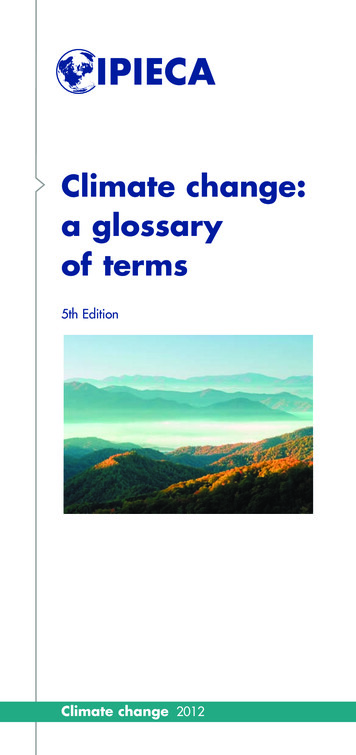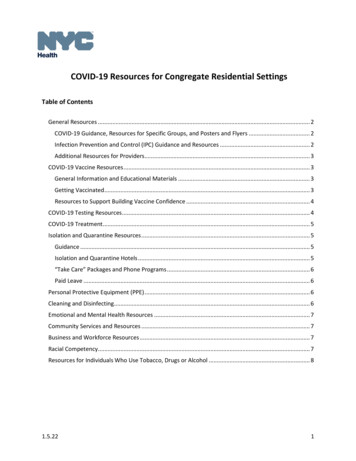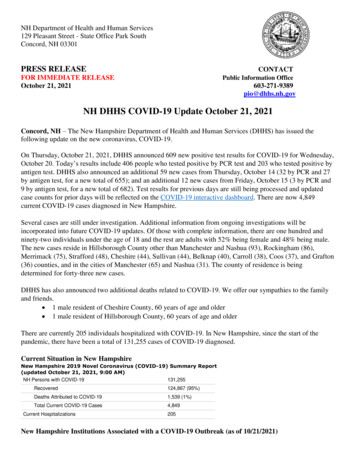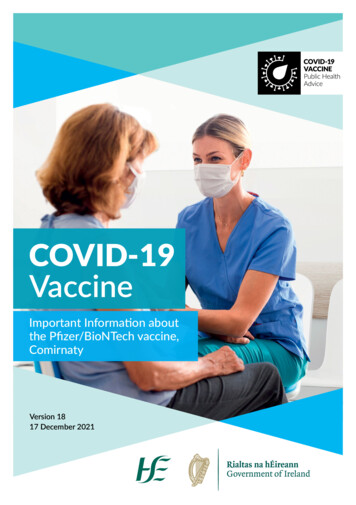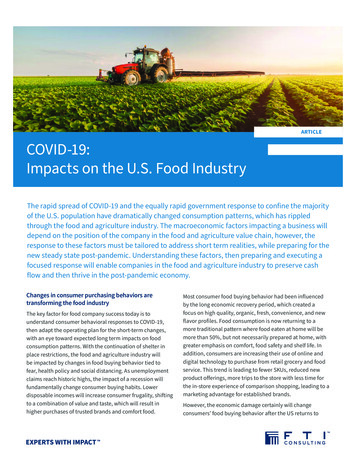
Transcription
ARTICLECOVID-19:Impacts on the U.S. Food IndustryThe rapid spread of COVID-19 and the equally rapid government response to confine the majorityof the U.S. population have dramatically changed consumption patterns, which has rippledthrough the food and agriculture industry. The macroeconomic factors impacting a business willdepend on the position of the company in the food and agriculture value chain, however, theresponse to these factors must be tailored to address short term realities, while preparing for thenew steady state post-pandemic. Understanding these factors, then preparing and executing afocused response will enable companies in the food and agriculture industry to preserve cashflow and then thrive in the post-pandemic economy.Changes in consumer purchasing behaviors aretransforming the food industryThe key factor for food company success today is tounderstand consumer behavioral responses to COVID-19,then adapt the operating plan for the short-term changes,with an eye toward expected long term impacts on foodconsumption patterns. With the continuation of shelter inplace restrictions, the food and agriculture industry willbe impacted by changes in food buying behavior tied tofear, health policy and social distancing. As unemploymentclaims reach historic highs, the impact of a recession willfundamentally change consumer buying habits. Lowerdisposable incomes will increase consumer frugality, shiftingto a combination of value and taste, which will result inhigher purchases of trusted brands and comfort food.Most consumer food buying behavior had been influencedby the long economic recovery period, which created afocus on high quality, organic, fresh, convenience, and newflavor profiles. Food consumption is now returning to amore traditional pattern where food eaten at home will bemore than 50%, but not necessarily prepared at home, withgreater emphasis on comfort, food safety and shelf life. Inaddition, consumers are increasing their use of online anddigital technology to purchase from retail grocery and foodservice. This trend is leading to fewer SKUs, reduced newproduct offerings, more trips to the store with less time forthe in-store experience of comparison shopping, leading to amarketing advantage for established brands.However, the economic damage certainly will changeconsumers’ food buying behavior after the US returns to
RESPONSES TO THE IMPACT OF COVID-19 ON THE U.S. FOOD INDUSTRYBEFORE COVID-19FTI Consulting, Inc.02DURING COVID-19 (NOW)AFTER COVID-19 (EXPECTED)Processed & Avoided processed and unhealthyFrozenfoods; focused on fresh foodsPurchasing processed andcomfort foods for a sense ofsecurity and indulgence; avoidingfresh produce, meat, poultry for avariety of reasonsExpanded palate for frozenvegetables, frozen and preparedmeals, bakery, canned fruits andvegetables, easy-to-cookMeals atHomeSignificant percentage of mealsaway from homeDislikes cooking at home; buying Will eat majority of meals atfrozen, center aisle, extended shelf home, versus 60% away fromlife foodhome pre-COVID-19SnackingHeavy snacking rather than fullmeals at homeStarting to eat meals versussnacks, with breakfast being thelargest beneficiaryContinued focus on meals athome, especially breakfastOrganicHeavy focus on mindfulconnection of organic food and“free from” claimsFocused on branded and comfortfoods previously neglectedHigher awareness of branded andethnic products; follows claimssupported by dataValueRetail grocery is an indulgenceand a form of conspicuousconsumptionHigh demand for value buyingwhich does not sacrifice qualityBalanced mix of convenience,quality, valueMarketingMarketing influenced food buying Fast, “in and out” buying; inpatternsstore marketing not effectivenormal operations. The economic contraction is the greatestsince World War II. When fear of the virus subsides, expect agradual reopening of the economy, starting with returning towork but with social distancing and ending with large socialgatherings such as sports, concerts and arts. The ability ofcompanies to adapt at speed is a function of understandingthe changes in consumption patterns and expectations forconsumption after the virus has been controlled.Summarized above are consumer buying behaviors beforeand during the virus outbreak, along with our expectationsfor the future.Success or failure in the current environment is drivenby adaptability speedWinners and losers in the food industry will be a function oftwo factors: the business segment position along the foodvalue chain (external factors) and the effectiveness of thecompany’s reaction to external factors (internal responses).A third dimension, which is extraordinarily important, is thespeed at which a company executes internal responses toDramatic reduction of in-storeexperience, shift to online, digitalmarketing
RESPONSES TO THE IMPACT OF COVID-19 ON THE U.S. FOOD INDUSTRYexternal factors. The ability to rapidly adjust the businessmodel will be the difference between financial successand hardship.Food companies should be prepared for an extended periodin which the consumer eats virtually every meal at home orthrough takeout/delivery. Given the current environment,expect that consumers will take 12 to 18 months beforefundamentally returning to reasonable levels of eating foodaway from home. For companies with food service as a keyelement, the ability to pivot to takeout/delivery, even if notpart of the ordinary business model, may be essential in theshort term. Restaurants that remain open will focus on curbside pickup, delivery and drive-thru, as well as protectingthe health of their employees. With less people in thekitchen, menus will be simplified, leading to a reduction inSKUs. Then, after all food service is re-opened, the consumerexperience will likely require changes, such as disposableWinnersFTI Consulting, Inc.menus, contact free ordering via tabletop kiosks, less tablesper square foot, and servers with masks/gloves.Food companies engaged in the production of retailgroceries, particularly staples, need to be prepared to meetsurging demand. Cooperatives and large conglomerates arelikely to rationalize food brands (to generate cash and tofocus attention on power brands). Similarly, the newentrant “innovators” will hit a brick wall bringing product tomarket and may need to be consolidated across segments(ethnic, frozen).The largest food companies which produce trustedstaples, have excellent supply chains, and typically havemore family-sized packaging, will be the most successful.Processed food will outperform other categories becausethe consumer has a renewed focus on shelf life over “freefrom” claims. Food manufacturers will need to rapidlyconvert plants that supported food service to supporting— Frozen will replace center-aisle staples to some extent. Center-aisle basics are often stocked inthe home pantry but not quickly consumed. Frozen is easy to cook with minimal preparation.— Processed Food and Brands are back, especially if simple to cook.— Eggs will continue to receive a surge in demand because they have a relatively long shelf lifeand are the easiest protein to cook.Losers— Fresh is the biggest loser across the board, due to short shelf life. Too many grocery trips, toomuch time required to cook at home. Health and wellness will be traded off for comfort foods.— Organic is a big loser along with foods making dubious health claims not backed by science.Organic won’t fit the “fast and frugal” nature of buying.— “Free from” was a trend that assumed the consumer was skeptical of science. COVID-19restores trust in science; expect a move away from generalized claims and certifications.— Startup brands will struggle as consumers shift from print/media to digital ads. Survivaldepends on ability to build new product awareness digitally.Mixed Results03— Private Label where the store has invested in a trusted platform like Great Value will win bigduring times of comfort and recession.— Private Label where there is no brand platform will do poorly, as these products rely on instore comparison. With quicker in-and-out shopping patterns, the consumer will shift totrusted brands.— Mindful Connection or Sustainability will bifurcate between value buyers and highdisposable income buyers, but consumers will want data, not claims.
RESPONSES TO THE IMPACT OF COVID-19 ON THE U.S. FOOD INDUSTRYretail grocery instead. These manufacturers will need toquickly rationalize the number of SKUs being produced toensure customers have adequate supplies of fast-movingbasic staples.Summarized above are the market segments that will drivewinners and losers in the food industry as the U.S. economyemerges from the impact of the virus.Survive and succeed by adapting at high speedThere is little time to move ahead of rapid changes that willmake or break a company in the food industry. The ability tomove from a “peacetime” to “wartime” operating model willdefine the winners and losers.FTI Consulting, Inc.04The most important action that food companies can takein the short term is to form a focused and prioritized actionplan that allocates appropriate resources to achieve theobjectives in a time-sensitive environment. Food companiessupplying retail grocery with staples must have exceptionallymanaged operations and supply chains. These companieswill be required to boost and shift production while facingstaffing challenges that include swings in labor availabilitydue to illness, employee safety, changing work hours,supply interruptions from critical vendors, transportationinterruptions, and SKU rationalization.Summarized below are three key areas food companiesshould address in the short term, once they understand theimpact of consumer purchasing behaviors on their business.AREACRITICAL ACTIONSSupply ChainOperations— Over-communicate with suppliers regarding orders, ability to meet delivery, forecast expectations.— Sales, Inventory and Operations Planning (SIOP) needs to be revisited.— Monitor all critical suppliers and their ability for continued supply, especially ingredients andpackaging.— Begin alternative supplier planning — activate secondary supplier programs.— Evaluate and proactively resolve logistics and transportation delays.— Establish a supply chain “War Room” with focus on demand, production, capacity and delivery.— Prioritize customer delivery and service levels, if not able to fill all orders.Plant Operations— Adjust production scheduling for volume reduction in certain SKUs; maximize production of highmargin/demand items.— Increase capacity based on type of production and plant capabilities.— Develop production-line flexibility to support shift in customer mix.— Determine alternative uses for excess capacity.— Develop provisions for increased biosecurity of the food, ingredients and/or animals at everymanufacturing plant.— Discuss with USDA/FDA Inspectors changes to inspection coverage.WorkforcePlanning— Develop rapid response teams to parachute into plants with high illness rates that threaten toslow down or shut down production.— Model and develop contingency plans for potential labor shortages in the plants.— Cross-train employees, since many will have periods of absenteeism.— Reimagine labor needs and secure, especially if seasonal labor is required.
RESPONSES TO THE IMPACT OF COVID-19 ON THE U.S. FOOD INDUSTRYFTI Consulting, Inc.05Evaluate resource capabilities and capacity to implement the short-term imperativesAdapting to changes with a high degree of speed and effectiveness will be a function of capabilities and capacity. Companiesneed to objectively determine whether internal resources are adequate to achieve their goals in the time frame required.Companies need a bias toward action and faster results rather than slow and steady. This market will move faster thananyone has ever experienced in their lifetime.We are available to provide an external perspective and experienced resources to assist companies to adapt, changeand succeed.KEITH F. COOPERSenior Managing Director 1 404.460.6265keith.cooper@fticonsulting.comRICHARD KOTTMEYERManaging Director 1 404.460.6200rich.kottomeyer@fticonsulting.comJOE DESANTISManaging Director 1 404.270.1441joe.desantis@fticonsulting.comThe views expressed herein are those of the author(s) and not necessarily the views of FTI Consulting, Inc., its management, its subsidiaries, its affiliates, or its otherprofessionals. FTI Consulting, Inc., including its subsidiaries and affiliates, is a consulting firm and is not a certified public accounting firm or a law firm.FTI Consulting is an independent global business advisory firm dedicated to helping organizations manage change, mitigate risk and resolve disputes: financial, legal,operational, political & regulatory, reputational and transactional. FTI Consulting professionals, located in all major business centers throughout the world, workclosely with clients to anticipate, illuminate and overcome complex business challenges and opportunities. 2020 FTI Consulting, Inc. All rights reserved. www.fticonsulting.comBILL STOTZERManaging Director 1 312.428.2679bill.stotzer@fticonsulting.com
Changes in consumer purchasing behaviors are transforming the food industry. The key factor for food company success today is to understand consumer behavioral responses to COVID-19, then adapt the operating plan for the short-term changes, with an eye toward expected long term impacts on food consumption patterns. With the continuation of .





